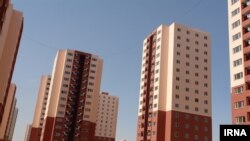The ambitious housing project championed by former hardline President Mahmoud Ahmadinejad has become a “headache” for the incumbent, Hassan Rouhani and his cabinet.
In a televised speech marking his first 100 days in office, Rouhani had singled out Mehr Housing project as being a major hurdle to Iran’s already faltering economy.
More than four years later, deputy minister of Roads and Urban Development admitted on Sunday, September 10 that there are still 200,000 half-built Mehr Housing units across the country, out of which 100,000 units are left without prospective buyers.
By removing all conditions and hurdles to applying for the ownership of the units, government hopes to encourage people to come forward and buy the units, Ahmad Asghari Mehrabadi said.
Government expectation has been expressed at a time that, according to its own official statistics, the Iranian housing market has been almost stagnant for months.
Based on statistics provided by CBI, 12,000 housing units in Tehran were sold in August which shows 11.2% and 33.2% drop, compared with the previous month and same period last year, respectively.
After the dramatic fall in the exchange rate of the national currency (rial) against the dollar people are mainly attracted to forex and gold markets.
Furthermore, the low quality of MHP units as well as lack of infrastructure and facilities, including reliable electricity and modern sewage systems, dissuade people from buying even the finished apartments.
Earlier, Minister of Roads and Urban development, Abbas Akhoundi had promised that the new units would be delivered “only after infrastructure is complete”.
Last year, Ahmad Asghari Mehrabadi had promised that the government planned to allocate 10 trillion rials (roughly $340 million, at the time, and currently $250 million at official rate) to Energy Ministry for development of infrastructures like water supply and electricity.
In the meantime, the existence of millions of vacated residential units outside the ambitious scheme has further complicated the problem.
There are currently 2.6 million vacated residential units across the country, a member of Majles’ (parliament) Legal and Judicial Commission, Abolfazl Torabi, said recently.
The number of vacated residential units are the same as the units built by MHP, so far.
Despite the huge number of vacated housing units, the price of apartments and rental fees have significantly increased in Iran. This is mostly due to the falling national currency, more than a real increase in dollar-based value.
The average price for one square meter (roughly 10.7 square feet) of residential units in the capital, Tehran, was 74 million rials (roughly $1700 at official rate) which shows 62.1% increase, comparing to last year.
Mehr Housing Project offered developers free state-owned land to build affordable residential units for first-time buyers. Since most citizens have difficulty getting small bank loans, homeowners who signed up for MHP were given 99-year mortgages guaranteed by the state. Banks acted as intermediaries between the developers and the government, and the Central Bank of Iran (CBI) was instructed to print more money to pay for the scheme.





